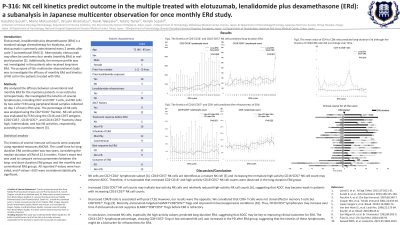Treatment of Relapsed/Refractory Myeloma
Poster Session 2
P-316: NK cell kinetics predict outcome in the multiple treated with elotuzumab, lenalidomide plus dexamethasone (ERd): a subanalysis in Japanese multicenter observation for once monthly ERd study.
Thursday, September 28, 2023
12:30 PM - 1:30 PM EEST


Kazuhito Suzuki, MD, PhD
Associate professor
The Jikei University School of Medicine, Tokyo, Japan
Introduction: Elotuzumab, lenalidomide plus dexamethasone (ERd) is a standard salvage chemotherapy for myeloma, and elotuzumab is commonly administered every 2 weeks after cycle 3 (conventional ERd). Alternatively, elotuzumab may often be used every four weeks (monthly ERd) in real-world practice. Additionally, the immune profile was not investigated in the patients who received long-term ERd. The purpose of this multicenter observational study was to investigate the efficacy of monthly ERd and kinetics of NK cell in the patients treated with ERd.
Methods: We analyzed the efficacy between conventional and monthly ERd for the myeloma patients in six institutes retrospectively. Moreover, we investigated the kinetics of natural killer (NK) cell by 2color flow cytometry (FCM) using peripheral blood samples, which were collected on day1 of ERd every cycles. The percentage of NK cells was analyzed by CD2+CD16+ fraction. The activity of NK cells was evaluated by FCM using CD16 and CD57 antigens. CD16+CD57-, CD16+CD57+, CD16-CD57+ fractions show high, intermediate, and low NK activities, respectively.
Results: Seventy-five patients were included in this study. The median age was 68 years. The median number of prior chemotherapies was two (1-5). The number of progressive disease (PD) and non-PD before ERd were 23 (30.7%) and 52 (69.3%), respectively. The frequency of PD before ERd was significantly lower in the monthly ERd group than in the conventional ERd group. In 26.9 months of median follow-up period, the 2-year progression-free survival (PFS) rate in the monthly ERd group was significantly longer than that in the conventional ERd group (95.0% and 62.0%, hazard ratio 0.082, P = 0.002). Concerning the kinetic of NK cells, we investigated the lymphocyte kinetics in twenty-one patients, including 12 of monthly ERd, 5 of PD before ERd, and 8 of PD after ERd groups. The median duration of ERd was 22.6 months, and the cutoff time for long ERd continuation was 2years. There was no significant difference of the NK cell percentage and activity between the monthly and conventional ERd groups. The NK cell percentage was significantly increasing overtime in the long ERd group compared to those in the short ERd group (P = 0.035). There was no significant difference of the NK cell activity between the long and short ERd groups. The low activity NK cell percentage was significantly increasing in the patients whose ERd outcome was PD even if ERd was effective, which was named PD after ERd group, compared to those in the non-PD after ERd group (P < 0.001). There was no significant difference of high and intermediate activity NK cell percentages between the PD and non-PD after ERd groups.
Conclusions: The efficacy of monthly ERd might be similar to those of conventional ERd, and monthly ERd might be an option considering balance between cost and effectiveness. The monthly ERd did not affect the kinetic of NK cell. The low activated NK cell percentage was increasing in the PD after ERd group.
Methods: We analyzed the efficacy between conventional and monthly ERd for the myeloma patients in six institutes retrospectively. Moreover, we investigated the kinetics of natural killer (NK) cell by 2color flow cytometry (FCM) using peripheral blood samples, which were collected on day1 of ERd every cycles. The percentage of NK cells was analyzed by CD2+CD16+ fraction. The activity of NK cells was evaluated by FCM using CD16 and CD57 antigens. CD16+CD57-, CD16+CD57+, CD16-CD57+ fractions show high, intermediate, and low NK activities, respectively.
Results: Seventy-five patients were included in this study. The median age was 68 years. The median number of prior chemotherapies was two (1-5). The number of progressive disease (PD) and non-PD before ERd were 23 (30.7%) and 52 (69.3%), respectively. The frequency of PD before ERd was significantly lower in the monthly ERd group than in the conventional ERd group. In 26.9 months of median follow-up period, the 2-year progression-free survival (PFS) rate in the monthly ERd group was significantly longer than that in the conventional ERd group (95.0% and 62.0%, hazard ratio 0.082, P = 0.002). Concerning the kinetic of NK cells, we investigated the lymphocyte kinetics in twenty-one patients, including 12 of monthly ERd, 5 of PD before ERd, and 8 of PD after ERd groups. The median duration of ERd was 22.6 months, and the cutoff time for long ERd continuation was 2years. There was no significant difference of the NK cell percentage and activity between the monthly and conventional ERd groups. The NK cell percentage was significantly increasing overtime in the long ERd group compared to those in the short ERd group (P = 0.035). There was no significant difference of the NK cell activity between the long and short ERd groups. The low activity NK cell percentage was significantly increasing in the patients whose ERd outcome was PD even if ERd was effective, which was named PD after ERd group, compared to those in the non-PD after ERd group (P < 0.001). There was no significant difference of high and intermediate activity NK cell percentages between the PD and non-PD after ERd groups.
Conclusions: The efficacy of monthly ERd might be similar to those of conventional ERd, and monthly ERd might be an option considering balance between cost and effectiveness. The monthly ERd did not affect the kinetic of NK cell. The low activated NK cell percentage was increasing in the PD after ERd group.
